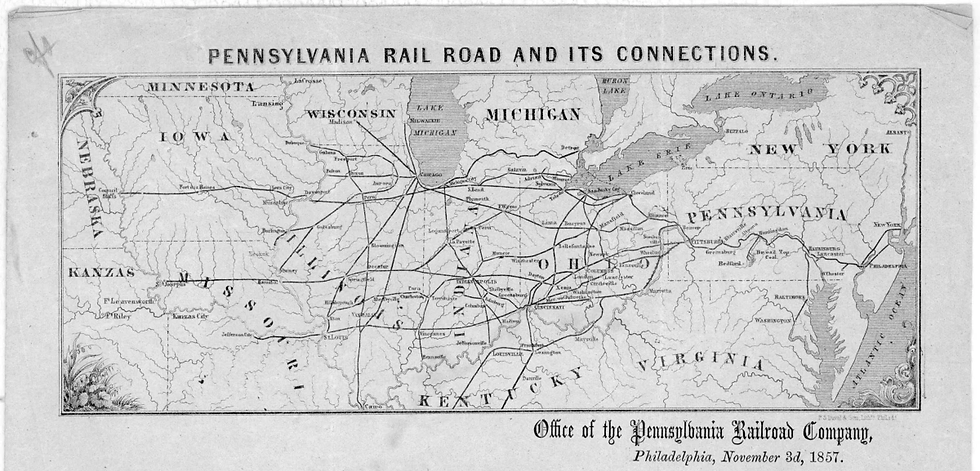Rails Across the Heartland: The Legacy of Railroads in Western Pennsylvania and Northeast Ohio
- Debbie Brown

- Feb 24
- 3 min read
The history of railroads in the United States is a story of innovation, expansion, and profound economic impact. From the early 19th century, when the first steam-powered trains were introduced, to the rise of modern freight and passenger systems, railroads have played a crucial role in shaping the nation’s landscape and economy. Western Pennsylvania and Northeast Ohio, in particular, stand out as critical regions in this narrative due to their industrial prominence and strategic location.
Early Development of Railroads in the U.S.
The first railroad in the United States, the Baltimore and Ohio Railroad (B&O), began operations in 1830, symbolizing the nation's embrace of rail technology. Railroads quickly expanded, linking urban centers, rural areas, and key ports. By the mid-19th century, the United States had an extensive railroad network that facilitated westward expansion and enabled the movement of goods and people on an unprecedented scale.

Western Pennsylvania: The Railroad and the Steel Industry
Western Pennsylvania's history with railroads is intertwined with the rise of its steel industry. Cities like Pittsburgh became major industrial hubs, fueled by the rich coal and iron ore deposits in the surrounding areas. Railroads, such as the Pennsylvania Railroad (PRR), played a pivotal role in transporting raw materials to steel mills and distributing finished products across the nation.
The PRR, established in 1846, became one of the largest and most influential railroads in the United States. Pittsburgh served as a critical junction for freight and passenger lines, connecting the Midwest to the East Coast. The railroads also supported the growth of smaller towns, such as Altoona, which became a hub for locomotive construction and maintenance.

Northeast Ohio: Railroads and Industrial Expansion
Similarly, Northeast Ohio benefited significantly from railroad development. Cleveland, Akron, and Youngstown became industrial powerhouses in the late 19th and early 20th centuries, largely due to their connectivity via railroads like the Erie Railroad and the Cleveland, Akron, and Columbus Railroad. These lines transported coal, iron, and other industrial goods essential to the region's factories.
Youngstown, in particular, saw tremendous growth as a center for steel production, supported by the Mahoning Valley's extensive rail network. Railroads provided the necessary infrastructure for the city to thrive, linking it to both raw material sources and markets.
Challenges and Decline
The dominance of railroads in Western Pennsylvania and Northeast Ohio began to wane in the mid-20th century due to the rise of automobiles, highways, and air travel. Additionally, the decline of the steel industry dealt a severe blow to the region’s economy, diminishing the demand for freight services. Despite these challenges, railroads have remained vital for freight transportation, with companies like Norfolk Southern and CSX continuing to operate in the region.
Legacy and Modern Relevance
Today, the legacy of railroads in Western Pennsylvania and Northeast Ohio is evident in preserved historic rail lines, museums, and revitalized freight corridors. Efforts to restore passenger rail services, such as the expansion of Amtrak, aim to recapture some of the prominence railroads once held in these regions.
The railroad industry's history in these areas is a testament to the transformative power of transportation infrastructure, fostering economic growth and connecting communities.
Click here to find more resources on American Railroads at Buhl Library.
References
Gallamore, R. E., & Meyer, J. R. (2014). American Railroads: Decline and Renaissance in the Twentieth Century. Harvard University Press.
Klein, M. (2008). The Life and Legend of Jay Gould. Johns Hopkins University Press.
Stover, J. F. (1997). American Railroads. University of Chicago Press.
Van Atta, J. R. (2009). Coal and Empire: The Birth of Energy Security in Industrial America. Oxford University Press.



Comments